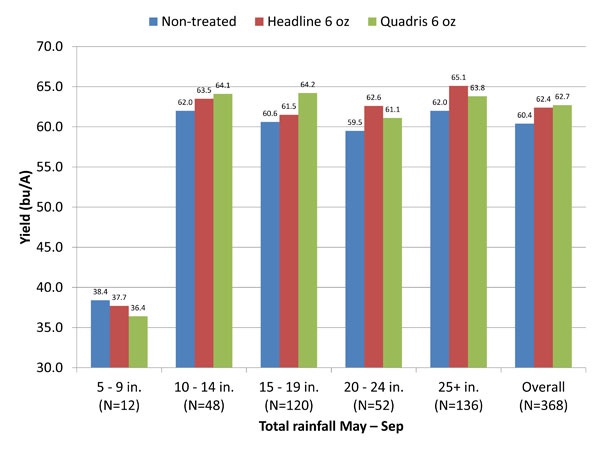July 20, 2012

Over the past few weeks, the primary question I have been asked is whether foliar fungicides still provide a benefit to drought-stressed crops. In issue 12 (June 22), I summarized corn foliar fungicide research trials conducted from 2008 to 2011. The greatest yield response and the greatest likelihood of a profitable fungicide application were observed where disease pressure was the highest. Foliar fungal disease pressure will be low in water-stressed fields, so the likelihood that fungicide application will be profitable is low.
From 2007 to 2011, my research program, with help from the Illinois Soybean Association, has evaluated foliar fungicides on soybean at Belleville (2007-2011), Bloomington (2007), DeKalb (2007-2011), Hoopeston (2007), Monmouth (2007-2011), Perry (2007-2011), Ridgway (2007-2011) and Urbana (2007-2011). Each location had one to four varieties and three or four replications, and fungicides were applied at the R3 stage of development (beginning pod formation). A nontreated control, Headline at 6 fl. oz./acre, and Quadris at 6 fl. oz./acre were the treatments.

Averaged over the 368 data points, both Headline and Quadris had statistically greater yields than the nontreated control, at a 95% level of confidence (see graph). To better understand how the fungicides affected soybean yields in locations and years with differing amounts of rain, I separated the data into categories based on the total rainfall received at each location from May to September (5-9 in., 10-14 in., 15-19 in., 20-24 in. and 25+ in.). Based on the results shown in the graph, a positive yield benefit was not observed with foliar fungicides in the most water-stressed category (5-9 in.).
The ability of foliar fungicides to improve "water-use efficiency" of water-stressed plants has been touted as a potential benefit. The only research that has been published in a peer-reviewed journal on this topic was in 2007 (Nason, M.A., J. Farrar, and D. Bartlett. 2007. Strobilurin fungicides induce changes in photosynthetic gas exchange that do not improve water use efficiency of plants grown under conditions of water stress. Pest Management Science 63:1191-1200). The authors evaluated different fungicides for their effect on water-use efficiency in both well-watered and water-stressed plants. They found that efficiency was increased slightly in well-watered plants, but it was reduced in water-stressed plants, indicating that fungicides could actually have a negative rather than positive effect on water-use efficiency and photosynthesis in water-stressed plants. This research, together with the University of Illinois soybean fungicide results, suggests that applying fungicide in areas of water-stressed plants and low disease pressure will not likely result in a beneficial yield response.
You May Also Like




